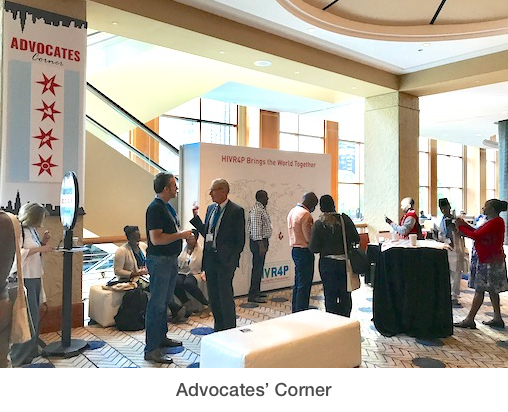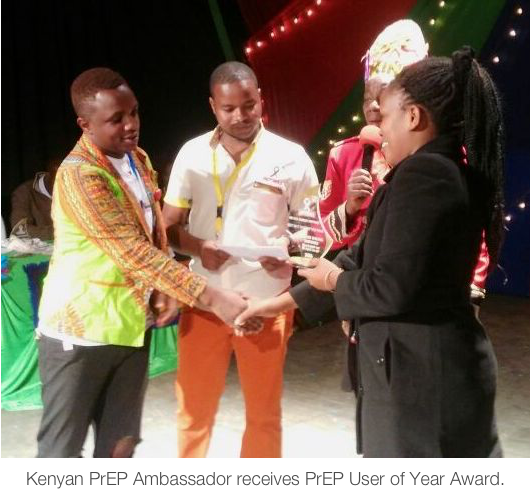Hello from Chicago! It’s unseasonably warm outside and predictably air-conditioned and chilly inside the conference center. As we don shawls and keep our jackets on, we’d be remiss if we didn’t note that this fair city is also home to one of the great PrEP marketing campaigns to date: the Chicago PrEP Working Group’s pro-PrEP, pro-sex PrEP4Love campaign has taglines like “contract heat,” “transmit love” and “spread tingle”.
It’s too chilly in the conference center for us to sport the sexy skin-to-skin styles of the PrEP, campaign, but we’ll try to use today’s update to transmit the heat of the conference—what got us thinking, talking and perhaps even tingling.
Let’s start with the warm fuzzies. There’s a lot of good feeling here. It’s as though the field of biomedical prevention has turned a corner and, recognizing there are more corners to go, is nevertheless enjoying a moment in the sun. Oral PrEP is rolling out—albeit slowly, the vaginal dapivirine ring continues to be explored, there’s that promising monkey study and then—to top it off—Tuesday brought the welcome news that the vaccine efficacy trial HVTN 702 has begun screening participants in South Africa.
This trial seeks to build on the positive result of the Thai trial known as RV144; it’s the first vaccine efficacy trial to launch in seven years. Kinda makes you tingle, right? If not, check out @vaccineadvocacy—the handle for the Vaccine Advocacy Resource Group. They’re at the conference, decoding science and setting advocacy goals in force. Follow along.
There was more heat—including the kind generated by friction—in sessions that tackled daily oral PrEP.
A small, prospective trial in Uganda looked at the amount of TDF/FTC in breastmilk among lactating women—and at the amount detectable in their breastfeeding infants. Even though TDF/FTC is widely used among women living with HIV throughout their pregnancy, there has been debate—often heated—about whether women who become pregnant while taking PrEP should discontinue it, or whether pregnant women should be allowed to initiate PrEP at all.
Excluding pregnant women could have a real impact on how programs are perceived—and how well they meet their goal of reaching people who need PrEP most. It’s already becoming an issue. Robyn Eakle (WRHI), presented initial data from a PrEP demonstration project in South Africa known as TAPS, noted that pregnancy was one of the main reason that HIV-negative women were excluded from joining the project. Women who became pregnant during the study could remain and choose whether to continue PrEP.
The Ugandan study shows very low to no drug in breastfeeding infants—which should provide additional reassurance to program implementers considering whether pregnant women should receive PrEP. There is a separate and equally urgent need to ensure that contraceptives are available to all women who want them, so that every pregnancy is wanted and planned. In other arenas, PEPFAR head Ambassador Debbi Birx has spoken about exploring co-packaging of PrEP and oral birth control pills as one way to get this “dual protection”—and a satellite session on Monday and Tuesday discussion in the Advocates’ Corner brought more on these multipurpose prevention technologies (MPTs).
Discussions got downright fiery on Tuesday when it came to the report, from Dr. Howard Grossman of the Cleveland Clinic that a man using oral PrEP had acquired HIV in spite of high adherence to his regimen. He acquired a multi-drug resistant strain of HIV that is resistant to TDF/FTC (and to other drugs)—and it may be that PrEP doesn’t protect against resistant strains. There’s a lot of research showing that drug resistant viruses are less likely to be transmitted than “wild-type” HIV—perhaps because the mutations that confer drug resistance also make it harder for the virus to establish new infections—but as these data show, it can still happen.
Do instances of people acquiring HIV mean PrEP is a no-go? Not at all. Anyone seeking eloquent expression of the complexities of communicating about, advocating for and using less-than-perfect prevention must read JD Davids’ piece, Two People Got HIV Despite PrEP—and Millions Get HIV Without It, at thebody.com.
Meanwhile, other PrEP data were a reminder that viruses aren’t the only ones that are resistant. Humans are too. Sarah Calabrese (George Washington University) presented on a significant barrier to PrEP uptake in some settings: providers.
Calabrese surveyed medical students in an effort to understand how patient risk behavior and motives may affect clinical judgement, and the results were sobering—willingness to prescribe PrEP was directly at odds with actual risk levels. When hypothetical patients were characterized as regular condom users, 90 percent of providers were willing to prescribe PrEP, but if patients indicated that they planned to discontinue condom use, willingness to prescribe dropped to 25 percent. Furthermore, providers were more comfortable with condom discontinuation in the context of patients seeking to conceive. Only a quarter found it acceptable to discontinue condom use in the service of greater intimacy.
Perhaps the only good news from these findings is a reminder that engaging providers is important everywhere—in the US, sub-Saharan Africa, Europe—everywhere that PrEP is being proposed, providers need to be part of the conversations about what it really means to PrEP4Love.
Providers wanting a real-time experience of this conversation should run, not walk, over to the Advocates’ Corner where Tuesday afternoon’s discussion was a terrific example of how global health really does include us all. In a discussion on women’s prevention, advocates, providers and programmers talked about what PrEP and female condom access—and lack thereof—looks like in their settings.
One Kenyan participant noted that she was surprised to hear about PrEP access issues here in the US, saying, “You were supposed to be a demonstration to us about how to do this.” In response, an American participant noted how African advocates had led the way by talking about PrEP even before it became available—and even as it rolls out slowly today.
A new report, PrEP Access in Europe, from the PrEP in Europe Initiative (PIEI) is another great reminder of how PrEP issues are truly global. The report tells the stories of people taking prevention into their own hands as they begin to seek ways to secure PrEP even though access is highly limited in a region with the fastest-growing HIV epidemic. The report calls on key stakeholders to take specific action.
Did some of the discussions have a little friction? Of course. That’s what happens when people get close to issues (or each other) in ways that matter. Be sure to check out our blog or watch the AN for a deeper dive into some of the issues coming up around discussions of the vaginal microbiome (the environment of healthy and not-so-helpful bacteria that live in our genital tracts). It’s a conversation that started in Durban, continued today—and that will be expanded even more in an upcoming webinar—stay tuned for details!
And for those on-site, be sure to add some Advocates’ Corner sessions to your conference itinerary. The full schedule of Advocates’ Corner is available here, and Wednesday’s sessions include:
- 10:00am – 10:30am: Stories that Matter: Storytelling and Advocacy
- 12:00pm – 1:00pm: HIV prevention for women and the dapivirine ring: Next steps for access and advocacy
- 2:30pm – 3:00pm: Digital Media Strategies and Partnerships to Furthering Prevention Knowledge and Policies
- 3:00pm – 3:30pm: Say It: Undetectable = Untransmittable
- 5:00pm – 6:00pm: Let’s Talk about Sex, Baby: Desire in the context of HIV prevention
- 6:00pm – 7:00pm: Launch for the SHARE.LEARN.SHAPE Survey
For the latest from the conference follow in real-time on Twitter and check out meeting coverage on aidsmap. And don’t just take our word for it, the Global HIV Vaccine Enterprise daily rapporteur summaries provide report backs from multiple viewpoints including a report from Morenike Ukpong from NHVMAS and others on yesterday’s sessions and opening. The conference organizers are archiving recordings of all sessions. Visit here to see the webcasts as they become available.

